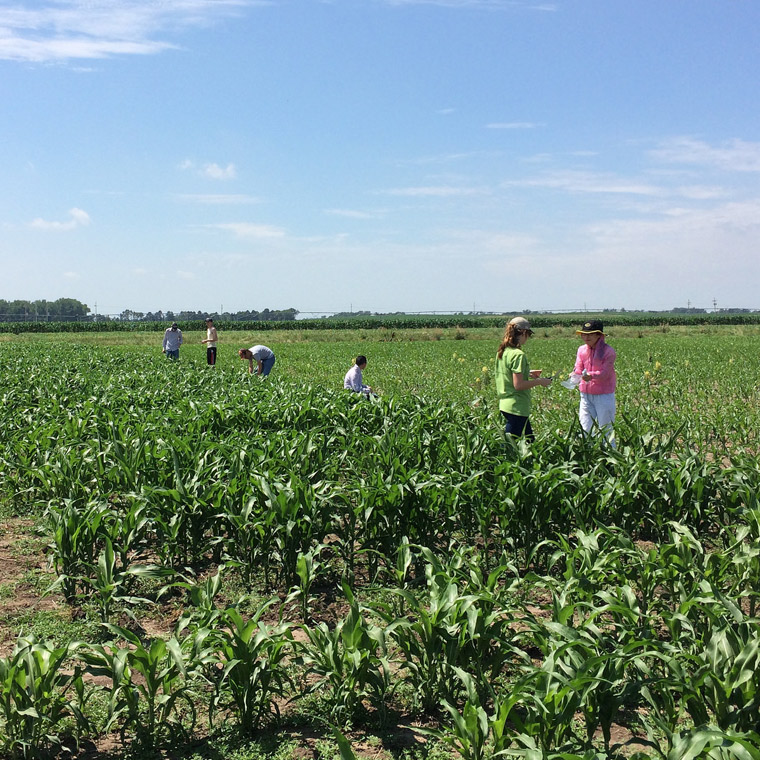Members
Moriyama*, Schnable*, Adamec, Doyle, Helikar, Walia, Zhang
*Co-leads
Plant roots continuously monitor and respond to their environments in complex and dynamic ways. Even within individual species, different accessions can vary significantly in their:
- response to and preference for various soil types
- ability to defend against soil borne pests and pathogens, and
- ability to promote the growth of different microbial taxa.
Root metabolites and functionally relevant, taxa-specific metabolites could also have been lost in the process of domestication or crop improvement. To understand this agronomically-important variation, models will be constructed describing how metabolic composition and pathway configuration varies across diverse genotypes. These models will examine gene expression and metabolite abundance in the roots of maize varieties and related wild species. Using genome-wide association studies (GWAS), allelic variation controlling changes in root metabolism will be identified. By combining gene expression and metabolomics data, predictive metabolic models will be developed that can simulate the metabolic impact of individual or combinations of engineered changes to plant root metabolism. Exudate production and soil microbial population composition data obtained in Aim 2 will be layered onto these metabolic networks, and the integrated model will guide the development of engineered plant varieties in Aim 3. Engineered plants developed in Aim 3 will be characterized and the results will be used to refine the predictive model. The final predictive model will enable testing of engineered changes and their combinations. It will also guide the identification of synthetic biology targets for design of root metabolism while minimizing deleterious secondary effects on metabolism.
Objectives
- Characterization of genetically controlled variation in root metabolism
- In-depth characterization of root metabolism across development and tissue types
- Develop and validate predictive models of root metabolism
- Develop computational tools and databases
Associated Publications
Chenyong Miao, Jinliang Yang and James C. Schnable. 2018. Optimizing the identification of causal variants across varying genetic architectures in crops. bioRxiv
DOI: https://doi.org/10.1101/310391
Dou Y, Li S, Yang W, Liu K, Du Q, Ren G, Yu B* and Zhang C .. 2017. Genome-wide Discovery of Circular RNAs in the Leaf and Seedling Tissues of Arabidopsis Thaliana. Current Genomics 18:360-365
DOI: https://doi.org/10.2174/1389202918666170307161124
Jia T, Zhang B, You C, Zhang Y, Zeng L, Li S, Johnson KCM, Yu B, Li, X, and Chen X.. 2017. he Arabidopsis MOS4-associated complex promotes microRNA biogenesis and precursor messenger RNA splicing. Plant Cell 29:2626-2643
DOI: https://doi.org/10.1105/tpc.17.00370
Li S, Liu K, Zhou B, Li M, Zhang S, Zeng L, Zhang C and Yu B*. . 2018. MAC3A and MAC3B, two core subunits of the MOS4-associated complex, positively impact miRNA biogenesis. Plant Cell
DOI: https://doi.org/10.1105/tpc.17.00953
Liang Z, Pandey P, Stoerger V, Xu Y, Qiu Y, Ge Y, Schnable JC.. 2017. Conventional and hyperspectral time-series imaging of maize lines widely used in field trials. GigaScience
DOI: https://doi.org/10.1093/gigascience/gix117
Liang Z., Schnable J.C.. 2018. Functional Divergence between Subgenomes and Gene Pairs after Whole Genome Duplications. Molecular Plant, Volume 11, Issue 3, 5 March 2018, Pages 388-397
DOI: https://doi.org/10.1016/j.molp.2017.12.010
Liu K, Du Q, Ren G, Yu B and Zhang C.. 2017. Identification of Differential Alternative Splicing Events with an Adjusted Beta-Distribution Model.. IEEE International Conference on Electro Information Technology (EIT)
DOI: https://doi.org/10.1109/EIT.2017.8053369
Malachy T Campbell, Harkamal Walia, Gota Morota. 2018. Utilizing random regression models for genomic prediction of a longitudinal trait derived from high-throughput phenotyping. bioRxiv
DOI: https://doi.org/10.1101/319897
Scully, E., T. Donze-Reiner, H. Wang, T. Eickhoff, F. Baxendale, P. Twigg, F. Kovacs, T. Heng-Moss, S. Sattler, and G. Sarath.. 2016. Identification of an orthologous clade of peroxidases that respond to feeding by greenbugs (Schizaphis graminum) in C4 grasses. Functional Plant Bio. 43: 1134-1148
DOI: 10.1071/FP16104
Shuxin Zhang, Yongchao Dou, Shengjun Li, Guodong Ren, David Chevalier, Chi Zhang, Bin Yu.. 2018. DAWDLE interacts with DICER-LIKE proteins to mediate small RNA biogenesis. Plant Physiology
DOI: https://doi.org/10.1104/pp.18.00354
Zhang Y, Ngu DW, Carvalho D, Liang Z, Qiu Y, Roston RL, Schnable JC. 2017. Differentially regulated orthologs in sorghum and the subgenomes of maize. The Plant Cell
DOI: https://doi.org/10.1105/tpc.17.00354

